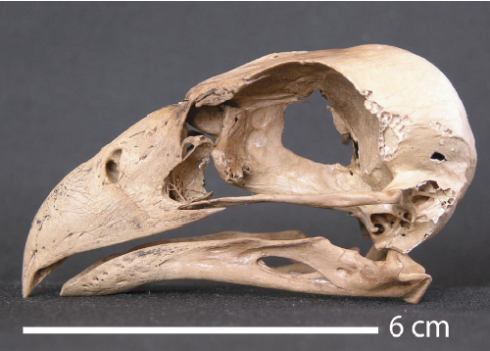
Skull and mandible of the extinct Bahamas Caracara, Caracara creightoni, Sawmill Sink, Abaco, The Bahamas. Features that distinguish C. creightoni from the living C. cheriway include the larger, stouter mandible and rostrum as well as the larger nares. Photo: Scienceblogs/GregLaden
|
Scienceblogs.com - Plant and animal fossils recently discovered from an island in the Bahamas tell a story of habitat change and human involvement in local extinction.
These finds are reported in a paper by Steadman et al. in the Proceedings of the National Academy of Sciences.
Most people with an interest in natural history know about one or more regions that were at one time covered by "a great inland sea." For instance, if you live in the American Midwest, you probably know that much of this region was covered by such a sea, evidenced by extensive limestone beds and other geological manifestations. As one learns more about these inland seas, one might get the impression that in the past there were a lot of inland seas! This is true, but it is easy to overlook the fact that there are many inland seas covering extensive regions today. One such expansive region is what we know of as the Gulf of Mexico, the Caribbean, and the area of the Bahamas. These are areas that consist largely of continent, not sea floor, but that are inundated by the sea during high water stands. Much of this region is exposed during Ica Age low water stands.
What this means is that "islands" such as the Bahamas are not the same kind of island as, say, the Galapagos or the Hawaiian Islands. The latter are volcanoes that arise from the sea floor, while the former are bits of continent that stick up above the high sea. So, as sea levels rise and fall in accordance with ice age cycles, this region shifts back and forth between islands of varying degrees of isolation to relatively large and contiguous blocks of continent. As this happens, we can presume that interesting biogeographical events take place.
There is not a large number of unique island species in the Bahamas, compared to Hawaii or the Galapagos, owing to this effect and their relative closeness to mainland even during high sea levels. However, there are some. But we also know that humans have been living on these islands for a long time, and one can ask the question, where there more island-adapted endemic species in the past that may have been wiped out by humans? Also, there are a number of missing species on these islands ... animals that live on the mainland (like in Florida, Mexico, Guatemala, etc.) Did these animals (and plants, for that matter) live on these islands at one time? Did they disappear from these islands "on their own" (owing to an inability to maintain viable population sizes on the smaller islands) or were they also locally wiped out by humans?
These are complex questions and the answers will not be easily come by. This set of questions fits well into a decades long debate on the effects of human populations on local animal communities.
The paper by Steadman et al reports a remarkable set of finds that will go a long way to address these issues. They report on fossils recovered from a "blue hole" sinkhole on Great Abaco Island, in the Bahamas. The preservational environment for many of these remains is remarkably good. It has even been possible to radiocarbon date some of the remains. Most of the material dates to between 4,200 and 1,000 years ago.
Among the more remarkable finds are the following:
-
Two extinct species of tortoise.
-
An extant crocodile that no longer lives in The Bahamas (but is found in Cuba).
-
An extant hawk, Gundlach's Hawk, no longer found in The Bahamas.
Human remains were also found.
A separate location that does not have dateable bones but that is believed by the researchers to be older is an owl roost. Owls fly around ingesting little critters, then regurgitate the bones (and fur, etc.) at habitually used roosting sites. This can produce very nice collections of microfauna, if there is a crack of crevasse or other spot in which the pellets can accumulate. This deposit included:
-
An extinct Bahamian flightless bird ... a type of rail
-
The locally extinct Gundlach's hawk
-
A flicker
-
A cave swallow
-
the Eastern Medowlark
-
Various mammals and rodents
Micro and macro remains of plants were also found and analyzed, providing the beginnings of a reconstruction of the overall ecology of the region at various points in time. The authors conclude:
[Both the plant and animal fossils from Sawmill Sink are beautifully preserved, greatly facilitating our upcoming morphological and systematic descriptions. These specimens also provide unparalleled opportunities to reconstruct ancient environments in the Bahamian Archipelago. Eventually we hope to be able to estimate long-term changes in such phenomena as fire regimes, plant communities, vertebrate turnover rates, body sizes of reptiles, terrestrial food webs including predator-prey relationships, and human impact on biotic communities. Such information is only beginning to be well documented in The Bahamas or on most other West Indian islands.]
David W. Steadman, Richard Franz, Gary S. Morgan, Nancy A. Albury, Brian Kakuk, Kenneth Broad, Shelley E. Franz, Keith Tinker, Michael P. Pateman, Terry A. Lott, David M. Jarzen, and David L. Dilcher (2007) Exceptionally well preserved late Quaternary plant and vertebrate fossils from a blue hole on Abaco, The Bahamas. PNAS Volume 104(50). Pp 19897-19902.
Original article
